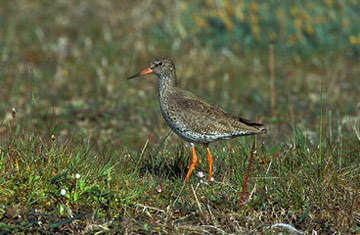
Redshank © John Power
Land managed in a way that Redshanks like is in short supply these days, and their breeding distribution has contracted considerably since our First Atlas, with them being proven to breed now in only seven tetrads. Their key requirements are a high water-table with local soil saturation, open landscapes with look-out posts, moderately dense tussock vegetation (preferably grass or sedge) of intermediate height, and nearby wetlands for feeding (Tucker and Heath 1994). In saline areas they mostly eat small crustaceans, molluscs and polychaete worms, and inland breeders take earthworms and tipulids (cranefly larvae).
Redshanks have occupied three types of site in the county during our First Atlas or since: saltmarsh, primarily along the Dee estuary, with a few birds in the Mersey; riverside flooded meadows; and other sites, especially alongside sand quarries or flooded agricultural grassland. However, Redshanks breeding in the second have now disappeared in Cheshire, whereas twenty years ago they were proven to breed in two tetrads along the lower River Weaver, with possible breeding alongside the non-tidal section of the River Dee, from where there were no records at all in this survey. Thirteen of the 25 tetrads with confirmed or probable breeding were estuarine saltmarsh, with the other birds in a variety of habitats, most on the edges of large waterbodies, sand quarries or the Frodsham Marsh deposit grounds, or in water-meadows/ grazing marshes.
The seven tetrads with confirmed breeding came from observers seeing adults with chicks in five cases, with an occupied nest observed on the Dee saltmarsh and birds performing their distraction display, trying to lure the observer away from their nesting area, in a Mersey tetrad. The 18 instances of probable breeding arose from seven observations of agitated behaviour (A), seven of display (D), and four sightings of pairs of birds.
With the expected ‘coastal squeeze’ from sea-level rise and development close to the sea, the areas of saltmarsh and coastal grasslands will reduce, and Redshank has been taken as an indicator species for research (Smart & Gill 2003). Saltmarsh supports the most breeding Redshanks, followed by coastal grassland, then inland grassland; but on saltmarsh and coastal grassland, few young survive because of predation and tidal flooding washing away nests, whereas on inland grasslands, half of the pairs in the East Anglian study areas produced at least one fledgling.
The county population, as in our First Atlas, depends crucially on estimates of the numbers on the Dee saltmarshes, with at most 10 or 15 pairs elsewhere. RSPB surveys of their land in SJ27 during 1996 and 2000 show that Redshanks vary greatly according to the intensity of grazing, with perhaps 100 pairs or more in the whole area. Redshanks are on the Amber List of species of conservation concern, partly because of their UK population decline. National surveys of waders breeding on wet lowland grasslands were conducted in 1982 and 2002, revealing a 29% drop in breeding Redshanks, and showing that nature reserves were by far the best sites for them, with cattle and sheep grazing and flooding managed to benefit breeding waders (Wilson et al 2005). Although no action targeted at their conservation is yet in place, there are national and local Biodiversity Action Plans for coastal and floodplain grazing marsh, that ought to benefit breeding Redshanks. The only local action on these habitats so far has been at the Gowy Meadows (SJ47H/ M), however, where the species has not been recorded for many years; at least fifty pairs nested there in 1907 and it would be good to see a return (Coward 1910).
Sponsored by www.deeestuary.co.uk

